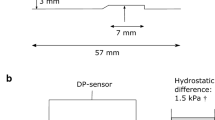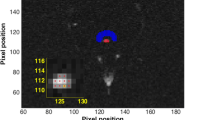Abstract
Purpose
Despite 100 years of study, the theories of cerebrospinal fluid (CSF) formation and absorption remain controversial. Measuring CSF flow through the aqueduct using magnetic resonance imaging (MRI) provides a unique insight into the physiology of CSF hydrodynamics. The published data in adults tend to refute rather than support the prevailing theories of CSF flow. There are limited data regarding this metric in children. This paper seeks to measure the aqueduct flow in normal and hydrocephalic children to help formulate a more complete theory of CSF flow.
Methods
Twenty-four children with communicating hydrocephalus aged from 4 months to 16 years underwent MRI flow quantification of the aqueduct measuring the net flow. The patients were compared to 19 controls.
Results
The controls revealed two different flow patterns: (1) an infantile pattern characterized by flow directed into the ventricular system and (2) a mature pattern with flow directed out of the ventricles, similar to the published findings in adults. In infants with communicating hydrocephalus, the aqueduct flow changed direction but was of similar magnitude compared with the controls (p = 0.001). In the older hydrocephalic children, the flow was elevated 7-fold, but the direction was unchanged compared to the controls (p = 0.002).
Conclusions
There is an abrupt change in the aqueduct CSF flow pattern at the age of 2 years from an infantile pattern to a mature pattern. These findings together with the findings in hydrocephalic children do not support the current theories of CSF hydrodynamics. A new theory of CSF circulation based on capillary absorption is presented.




Similar content being viewed by others
References
Bateman GA, Napier BD (2011) External hydrocephalus in infants: six cases with MR venogram and flow quantification correlation. Childs Nerv Syst. doi:10.1007/s00381-011-1549-z
Bateman GA, Smith RL, Siddique SH (2007) Idiopathic hydrocephalus in children and idiopathic intracranial hypertension in adults: two manifestations of the same pathophysiological process? J Neurosurg 107(6 Suppl):439–444
Bateman GA, Stevens SA, Stimpson J (2009) A mathematical model of idiopathic intracranial hypertension incorporating increased arterial inflow and variable venous outflow collapsibility. J Neurosurg 110:446–456
Bering EA Jr, Satto O (1963) Hydrocephalus: changes in formation and absorption of cerebrospinal fluid within the cerebral ventricles. J Neurosurg 20:1050–1063
Bering EA (1952) Water exchange of central nervous system and cerebrospinal fluid. J Neurosurg 9:275–287
Blomquist HK, Sundin S, Ekstedt J (1986) Cerebrospinal fluid hydrodynamic studies in children. J Neurol Neurosurg Psychiatry 49:536–548
Bradley WG Jr, Kortman KE, Burgoyne B (1986) Flowing cerebrospinal fluid in normal and hydrocephalic states: appearance on MR images. Radiology 159:611–616
Bulat M, Klarica M (2011) Recent insights into a new hydrodynamics of the cerebrospinal fluid. Brain Res Rev 65:99–112
Cerda M, Manterola A, Ponce S, Basuri L (1985) Electrolyte levels in the CSF of children with nontumoral hydrocephalus. Child Nerv Syst 1:306–311
Cserr HF (1971) Physiology of the choroid plexus. Physiol Rev 51:273–311
De Olivera RS, Machado HR (2003) Transcranial color-coded Doppler ultrasonography for evaluation of children with hydrocephalus. Neurosurg Focus 15(4):ECP3
Edsbagge M, Stacrk G, Zetterberg H, Ziegellitz D, Wikkelso C (2011) Spinal cerebrovascular fluid volume in healthy elderly individuals. Clin Anatomy. doi:10.1002/ca.21153
Gatehouse PD, Rolf MP, Graves MJ, Hofman MBM, Totman J, Werner B et al (2010) Flow measurement by cardiovascular magnetic resonance: a multi-centre multi-vendor study of background phase offset errors that can compromise the accuracy of derived regurgitant or shunt flow measurements. J Cardiovasc Magn Reson 12:5–12
Gideon P, Thomsen C, Stahlberg F, Henriksen O (1994) Cerebrospinal fluid production and dynamics in normal aging: a MRI phase-mapping study. Acta Neurol Scand 89:362–366
Hayakawa K, Konishi Y, Kuriyama M, Konishi K, Matsuda T (1993) Cerebrospinal fluid flow void in children. Neuroradiology 35:443–446
Hirabuki N, Watanabe Y, Mano T, Fujita N, Tanaka H, Ueguchi T, Nakamura H (2000) Quantitation of flow in the superior sagittal sinus performed with cine phase-contrast MR imaging of healthy and achondroplastic children. AJNR Am J Neuroradiol 21:1497–1501
Kimelberg HK (2004) Water homeostasis in the brain: basic concepts. Neuroscience 129:851–860
La Mattina JC, Golan DE (2008) Pharmacokinetics. In: Golan DE (ed) Principles of pharmacology: the pathophysiologic basis of drug therapy, 2nd edn. Lippincott Williams and Wilkins, Baltimore, p 45
Leliefeld PH, Gooskens RHJM, Vicken KL, Ramos LM, van der Grond J, Tulleken CAF et al (2008) Magnetic resonance imaging for quantitative flow measurement in infants with hydrocephalus: a prospective study. J Neurosurg Pediatrics 2:163–170
Maki Y, Kokubo Y, Nose T, Yoshii Y (1976) Some characteristic findings of isotope cisternograms in children. J Neurosurg 45:56–59
Masserman JH (1934) Cerebrospinal hydrodynamics. 4 Clinical experimental studies. Arch Neurol Psychiatry (Lond) 32:523–553
Matsumae M, Kikinis R, Morocz IA, Lorenzo AV, Sandor T, Albert MS et al (1996) Age-related changes in intracranial compartment volumes in normal adults assessed by magnetic resonance imaging. J Neurosurg 84:982–991
Milhorat TH, Hammock MK, Chein T, Davis DA (1976) Normal rate of cerebrospinal fluid formation five years after bilateral choroid plexectomy. J Neurosurg 44:735–739
Oi S, Di Rocco C (2006) Proposal of “evolution theory in cerebrospinal fluid dynamics” and minor pathway hydrocephalus in developing immature brain. Child Nerv Syst 22:662–669
Penn RD, Basati S, Sweetman B, Guo X, Linninger A (2011) Ventricle wall movements and cerebrospinal fluid flow in hydrocephalus. J Neurosurg. doi:10.3171/2010.12.JNS10926
Piechnik SK, Summers PE, Jezzard P, Byrne JV (2008) Magnetic resonance measurement of blood and CSF flow rates with phase contrast: normal values, repeatability and CO2 reactivity. Acta Neurochir Suppl 102:263–270
Rapoport SI (1997) Brain oedema and the blood–brain barrier. In: Welsh KMA, Caplan Reis DJ, Siesjo BK, Weir B (eds) Primer on cerebrovascular diseases. Academic, London, pp 25–28
Redzic ZB, Segal MB (2004) The structure of the choroid plexus and the physiology of the choroid plexus epithelium. Avd Drug Deliv Rev 56:1695–1716
Renkin EM, Crone C (1966) Microcirculation and capillary exchange. In: Greger R, Windhorst U (eds) Comprehensive human physiology. Springer, Berlin, pp 1965–1979
Rohr AC, Reidel C, Fruehauf MC, van Baalen A, Bartsch T, Hedderich J, Alfke K, Doerner L, Jansen O (2011) MR imaging findings in patients with secondary intracranial hypertension. AJNR Am J Neuroradiol. doi:10.3174/ajnr.A2463
Saint-Rose C, LaCombe J, Pierre-Kahn A, Renier D, Hirsch JF (1984) Intracranial venous sinus hypertension: cause or consequence of hydrocephalus in infants? J Neurosurg 60:727–736
Shulman K, Ransohoff J (1965) Sagittal sinus pressure in hydrocephalus. J Neurosurg 23:169–173
Statz A, Felgenhauer K (1983) Development of the blood–brain barrier. Dev Med Child Neurol 25:152–161
Sufianov AA, Sufianova GZ, Iakimov IA (2010) Endoscopic third ventriculostomy in patients younger than 2 years: outcome analysis of 41 hydrocephalus cases. J Neurosurg Pediatrics 5:392–401
Thomsen C, Stahlberg F, Stubgard M, Nordell B (1990) Fourier analysis of cerebrospinal fluid flow velocities: MR imaging study. Radiology 177:659–665
Turner L (1961) The structure of arachnoid granulations with observations on their physiology and pathophysiological significance. Ann R Coll Surg Engl 29:237–264
Unal O, Kartum A, Avcu S, Etlik O, Arslan H, Bora A (2009) Cine phase-contrast MRI evaluation of normal aqueductal cerebrospinal fluid flow according to sex and age. Diag Interv Radiol 15:227–231
Yoshida K, Takahashi H, Saijo M, Ueguchi T, Tanaka H, Fujita N, Murase K (2009) Phase-contrast MR studies of CSF flow rate in the cerebral aqueduct and cervical subarachnoid space with correlation-based segmentation. Magn Reson Med Sci 8:91–100
Conflict of interest disclosure
The authors declare no conflict of interest concerning the materials or methods used in this study or the findings specified in this paper.
Author information
Authors and Affiliations
Corresponding author
Rights and permissions
About this article
Cite this article
Bateman, G.A., Brown, K.M. The measurement of CSF flow through the aqueduct in normal and hydrocephalic children: from where does it come, to where does it go?. Childs Nerv Syst 28, 55–63 (2012). https://doi.org/10.1007/s00381-011-1617-4
Received:
Accepted:
Published:
Issue Date:
DOI: https://doi.org/10.1007/s00381-011-1617-4




